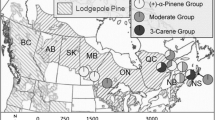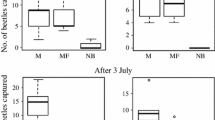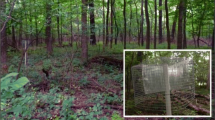Abstract
After living ponderosa pines were baited with either female-infested bolts or synthetic pheromones,Dendroctonus brevicomis were caught on sticky screens throughout trapping periods of 15–46 days; however, large numbers of beetles were trapped during only a small portion (5–10 days) of these trapping periods. The most attractive portions of trees attacked contained 3–6 beetles dm2, in galleries ca. 2 cm long. Catch increased following addition of males to female-infested bolts, supporting the hypothesis that male-produced frontalin is an attractive pheromone of the western pine beetle. Catch at bolts removed from trees under attack was strongly dependent upon levels of boring activity. We found no evidence of interruption of the response to attractants during host colonization.
Similar content being viewed by others
References
Bedard, W.D., Silverstein, R.M., andWood, D.L. 1970. Bark beetle pheromones.Science 167:1638–1639.
Bedard, W.D., Tilden, P.E., Wood, D.L., Silverstein, R.M., Brownlee, R.G., andRodin, J.O. 1969. Western pine beetle: Field response to its sex pheromone and a synergistic host terpene, myrcene.Science 164:1284–1285.
Bedard, W.D., Tilden, P.E., Wood, D.L., Lindahl, K.Q., Jr., andRauch, P.A. 1980a. Effects of verbenone andtrans-verbenol on the response ofDendroctonus brevicomis to natural and synthetic attractant in the field.J. Chem. Ecol. 6:997–1013.
Bedard, W.D., Wood, D.L., Tilden, P.E., Lindahl, K.Q., Jr., Silverstein, R.M., andRodin, J.O. 1980b. Field responses of the western pine beetle and one of its predators to host- and beetle-produced compounds.J. Chem. Ecol. 6:625–641.
Browne, L.E., Wood, D.L., Bedard, W.D., Silverstein, R.M., andWest, J.R. 1979. Quantitative estimates of the western pine beetle attractive pheromone components,exo-brevicomin, frontalin, and myrcene in nature.J. Chem. Ecol. 5:397–414.
Byers, J.A., andWood, D.L. 1980. Interspecific inhibition of the response of the bark beetles,Dendroctonus brevicomis andIps paraconfusus, to their pheromones in the field.J. Chem. Ecol. 6:149–164.
Coster, J.E., Payne, T.L., Hart, E.R., andEdson, L.J. 1977. Aggregation of the southern pine beetle in response to attractive host trees.Environ. Entomol. 6:725–731.
Fleiss, J.L. 1973. Statistical Methods for Rates and Proportions. John Wiley & Sons, New York. 223 pp.
Gara, R.I., Vité, J.P., andCramer, H.H. 1965. Manipulation ofDendroctonus frontalis by use of a population aggregating pheromone.Contrib. Boyce Thompson Inst. Plant Res. 23:55–56.
Johnson, N.L., andKotz, S. 1969. Discrete Distributions. Houghton Mifflin Co., Boston, pp. 53–55.
Kinzer, G.W., Fentiman, A.F. Jr., Page, T.F., Jr., Foltz, R.L., Vité, J.P., andPitman, G.B. 1969. Bark beetle attractants: Identification, synthesis, and field bioassay of a new compound isolated fromDendroctonus.Nature 221:477–478.
Libbey, L.M., Morgan, M.E., Putnam, T.B., andRudinsky, J.A. 1974. Pheromones released during inter- and intra-sex response of the scolytid beetleDendroctonus brevicomis.J. Insect Physiol. 20:1667–1671.
Mehra, K.L., andSarangi, J. 1967. Asymptotic efficiency of certain rank tests for comparative experiments.Ann. Math. Stat. 38:90–107.
Miller, J.M., andKeen, F.P. 1960. Biology and Control of the Western Pine Beetle. U.S. Dep. Agric. Misc. Publ. 800. Washington, D.C. 381 pp.
Miller, R.G. 1966. Simultaneous Statistical Inference. McGraw-Hill Book, New York. pp. 14–15.
Pitman, G.B., Vité, J.P., Kinzer, G.W., andFentiman, A.F., Jr. 1969. Specificity of population-aggregating pheromones inDendroctonus.J. Insect Physiol. 15:363–366.
Renwick, J.A.A., andVité, J.P. 1970. Systems of chemical communication inDendroctonus.Contrib. Boyce Thompson Inst. Plant Res. 24:283–292.
Silverstein, R.M. 1970. Methodology for isolation and identification of insect pheromones—examples from Coleoptera, pp. 285–299,in D.L. Wood, R.M. Silverstein, and M. Nakajima (eds.). Control of Insect Behavior by Natural Products. Academic Press, New York.
Silverstein, R.M., Brownlee, R.G., Bellas, T.E., Wood, D.L., andBrowne, L.E. 1968. Brevicomin: Principal sex attractant in the frass of the western pine beetle.Science 159:889–891.
Stephen, F.M., andDahlsten, D.L. 1976. The temporal and spatial arrival pattern ofDendroctonus brevicomis in ponderosa pine.Can. Entomol. 108:271–282.
Tilden, P.E., Bedard, W.D., Wood, D.L., andStubbs, H.A. 1981. Interruption of response ofDendroctonus brevicomis to its attractive pheromone by components of the pheromone.J. Chem. Ecol. 7:183–196.
Vité, J.P., andGara, R.I. 1962. Volatile attractants from ponderosa pine attacked by bark beetles (Coleoptera: Scolytidae).Contrib. Boyce Thompson Inst. Plant Res. 21:251–273.
Vité, J.P., andPitman, G.B. 1968. Bark beetles aggregation: Effect of feeding on the release of pheromones inDendroctonus andIps.Nature 281:169–170.
Vité, J.P., andPitman, G.B. 1969. Aggregation behaviour ofDendroctonus brevicomis in response to synthetic pheromones.J. Insect Physiol. 15:1617–1622.
Wood, D.L. 1972. Selection and colonization of ponderosa pine by bark beetles, pp. 101–117,in H.F. van Emden (ed.). Insect/Plant Relationships. Blackwell Scientific Publications, Oxford.
Wood, D.L. 1977. Manipulation of forest insect pests, pp. 369–384,in H.H. Shorey and J.J. McKelvey, Jr. (eds.). Chemical Control of Insect Behavior: Theory and Application. John Wiley & Sons, New York.
Wood, D.L., andBedard, W.D. 1977. The Role of pheromones in the population dynamics of the western pine beetle, pp. 643–652,in D. White (ed.). Proceedings of the XV International Congress of Entomology, Washington, D.C. August 19–27, 1976. Entomological Society of America, College Park, Maryland.
Wood, D.L., andBushing, R.W. 1963. The olfactory response ofIps confusus (LeConte) (Coleoptera: Scolytidae) to the secondary attraction in the laboratory.Can. Entomol. 95:1066–1078.
Wood, D.L., andVité, J.P. 1961. Studies on the host selection behavior ofIps confusus (LeConte) (Coleoptera: Scolytidae) attackingPinus ponderosa.Contrib. Boyce Thompson Inst. Plant Res. 21:79–95.
Author information
Authors and Affiliations
Additional information
Coleoptera: Scolytidae. Trade names and commercial enterprises or products are mentioned solely for information and do not constitute endorsement by the U.S. Department of Agriculture or University of California.
Rights and permissions
About this article
Cite this article
Bedard, W.D., Lindahl, K.Q., Tilden, P.E. et al. Behavior of the western pine beetle during host colonization. J Chem Ecol 11, 1249–1261 (1985). https://doi.org/10.1007/BF01024113
Received:
Accepted:
Issue Date:
DOI: https://doi.org/10.1007/BF01024113




